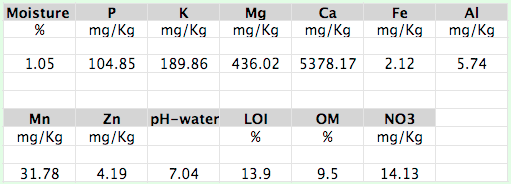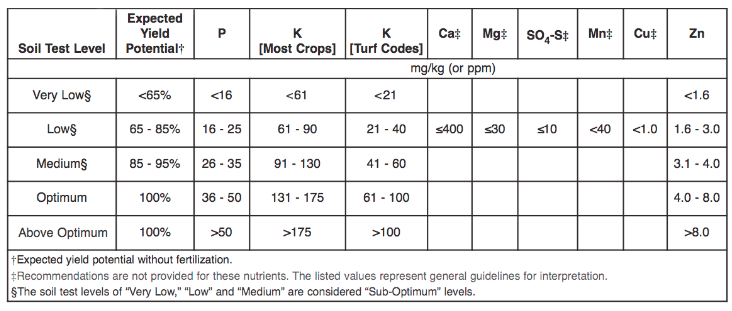And more on our garden soil

The second test performed by Cornell Nutrient Analysis Lab was their #1030 Soil Fertility Test. The results, above, are expressed in mg/Kg, equivalent to parts per million (ppm). The table below shows recommended ranges for some of these nutrients in farm or garden soil.

The previous article on soil tests mentioned some high total, metal levels, like those for iron (Fe) and aluminum (Al). But these metals only harm your plants if the soil is acid, which will dissolve the metals and make them available to the plants. You can see at the top that the soil’s pH is 7.04, nearly neutral, neither acid nor alkaline. So we’re in good shape there, the plants will do fine with the Fe and Al levels in our soil since most of the iron and aluminum is insoluble.
On the right you can see that the phosphorus (P) and potassium (K) levels in the soil are high, a bit above the optimum, in fact. This means that you do not need to fertilize in any way that will add P in particular, we’ve got enough already.
We also have plenty of the trace, soluble, minerals magnesium (Mg), calcium (Ca), iron (Fe), aluminum (Al), and zinc (Zn). The only mineral that’s on the low side is manganese (Mn) but even then it seems that you’d only try to add manganese to your soil if it’s less than 20 ppm and we have about 32. Remember that all living things need these minerals, they just don’t want too much of them.
Then we come to loss on ignition (LOI) and organic matter (OM). The levels are very good, around 10%, well above what some would consider the minimum amount of organic matter, which is 2%. Mind you though, this soil is taken from a plot that gets covered with hay every year. I even take my weeds (and my neighbors’ weeds!) and layer them underneath the hay where they decompose quickly. There’s a name for this, it’s called strip mulching. Between the hay and the weeds I’m adding a lot of organic matter to this soil, your plot probably is different if you’re not adding organic matter to it.
Finally we get the soil nitrate level (NO3), about 14 ppm. One way agronomists talk about soil nitrate is to refer to specific plants and their nitrate requirements. For example, if you grow sweet corn you want plenty of nitrogen, at least 25 ppm of nitrate. So to grow the best possible corn you’d find a way to add nitrogen to your plot, by adding manure or blood meal, or by growing a cover crop and tilling it in. Tomatoes, peppers, and squash are similar in their nitrate needs, ideally they get nitrate in the range of 25 to 50 ppm. Of course these plants grow and make great vegetables with less than 25 ppm nitrate but if you want the best possible outcome you’d add nitrogen in some form.
If you do add some form of nitrogen follow the instructions carefully! Over-fertilizing with N will give you big plants with lots of foliage and not much else. Great for cabbage, not so good for tomatoes.
Here’s a nice PDF on soil testing, if you’re interested in reading more: Understanding the Numbers in Your Soil Test Report.
Brian O